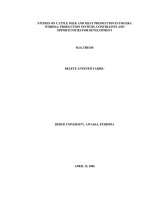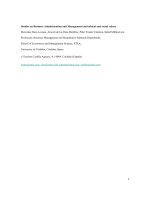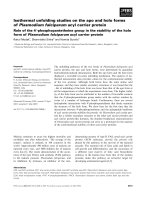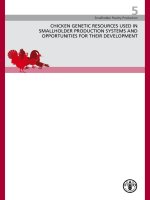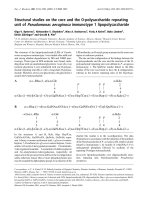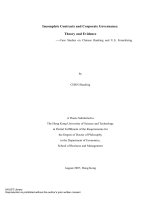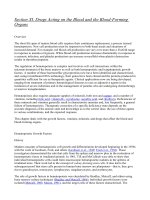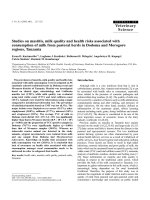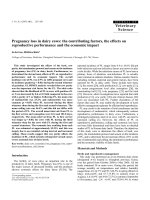STUDIES ON CATTLE MILK AND MEAT PRODUCTION IN FOGERA WOREDA: PRODUCTION SYSTEMS, CONSTRAINTS AND OPPORTUNITIES FOR DEVELOPMENT doc
Bạn đang xem bản rút gọn của tài liệu. Xem và tải ngay bản đầy đủ của tài liệu tại đây (921.27 KB, 175 trang )
STUDIES ON CATTLE MILK AND MEAT PRODUCTION IN FOGERA
WOREDA: PRODUCTION SYSTEMS, CONSTRAINTS AND
OPPORTUNITIES FOR DEVELOPMENT
M.Sc.THESIS
BELETE ANTENEH TARIKU
DEBUB UNIVERSITY, AWASSA, ETHIOPIA
APRIL 15, 2006
STUDIES ON CATTLE MILK AND MEAT PRODUCTION IN FOGERA
WOREDA: PRODUCTION SYSTEMS, CONSTRAINTS AND
OPPORTUNITIES FOR DEVELOPMENT
BELETE ANTENEH TARIKU
A THESIS SUBMITTED TO THE DEPARTMENT OF ANIMAL AND RANGE
SCIENCES, AWASSA COLLEGE OF AGRICULTURE, SCHOOL OF
GRADUATE STUDIES
DEBUB UNIVERSITY
AWASSA, ETHIOPIA
IN PARTIAL FULFILLMENT OF THE REQUIREMENTS FOR THE
DEGREE OF MASTER OF SCIENCE
ANIMAL AND RANGE SCIENCES
(SPECIALIZATION: DAIRY SCIENCES)
APRIL 15, 2006
ii
APPROVAL SHEET 1
This is to certify that the thesis entitled “Studies on Cattle Milk and Meat Production in
Fogera Woreda: Production Systems, Constraints and Opportunities for Development”
submitted in partial fulfillment of the requirements for the degree of Master of Science
in Animal and Range sciences with a Specialization of Dairy Science
of the Graduate
Program of the Department of Animal and Range sciences
, Awassa College of
Agriculture, and is a record of original research carried out by Belete Anteheh Tariku
I.D.No AWR/2268/96,under my supervision, and no part of the thesis has been
submitted for any other degree or diploma.
The assistance and the help received during the course of this investigation has been
duly acknowledged. Therefore, I recommended that it will be accepted as fulfilling the
thesis requirements.
____________________ ________________ _______________
Name of main advisor signature Date
____________________ ________________ _______________
Name of main Co-advisor signature Date
iii
MSc Thesis Evaluation Sheet
We, the undersigned, members on the Board of Examiners of _______________have
read and evaluated______________________________________________________
and examined the candidate. This is therefore to certify that the thesis has been for the
degree________________________________________________________________
_____________________________________________________________________
___________________ _____________________ ________________
Name of Chair Person Date Signature
___________________ _____________________ ________________
Name of Main Advisor Date Signature
___________________ _____________________ ________________
Name of Internal Examiner Date Signature
___________________ _____________________ ________________
Name of External Examiner Date Signature
iv
ACKNOWLEDGEMENT
First of all, I would like to pass my great indebtedness to those individuals and
institution that were involved directly or indirectly in this work so that my study came
to success.
My first earnest appreciation goes to my research advisors, Dr. Fekadu Beyene, Dr.
Azage Tegegne and Dr.Birhanu Gebremedihin for spending their precious time to give
genuine and regular advice, and to correct this manuscript from the very beginning to
very end. I am also grateful for ILRI’s information center in the searching and the
provision of the requested publications and reference materials during the preparation
of this thesis that enabled me to complete the write up timely.
I would like to extend my thanks to ILRI-IPMS (Improving Productivity and Market
Success) Project for financing my study through the IPMS-Fogera Pilot Learning Site
(PLS), without which this work would not have been possible. My thanks to IPMS
Fogera staff Ato Yirgalem Assegid and Teshome Derso in timely adjusting my
financial requests and arranging the vehicle and the computer for my study works. I am
especially thankful to Muluhiwot Getachew in her immediate facilitations to my
financial requests and transferring the working budgets on the right time. I also thank
all the staff members of the Fogera woreda agricultural and rural office in a day-to-day
encouragement during my study. I especially thank the enumerators and data collectors
v
and the staff members Ashage Abate, Melese Damite, Solomo Hagos, Ayenew Guadie
and Habte W/Silassie who were giving me transport services to the surveyed kebeles.
I am also thankful to Dr. Eshte Dejene in finding and creating links with the sponsor
NGO for my study. I am thankful to Ato Abebaw Getachew and Zemen Ayalew for
their kind cooperation starting from shaping up of the data to data analysis by taking
their precious time.
My deepest gratitude to goes to all my elder and younger brothers and sisters and all
my colleagues who offered me comprehensive moral support and treatment that
enabled me succeed though out my academic life. I owe them more than a mere
expression of thanks
Above all, I praise the Almighty God for giving me the courage and strength in my
life.
vi
DEDICATION
To my wife W/zo Desta Zeleke Hibistu for her strength and kindness and my lovely
daughter Kidist Belete
vii
ABBREVIATIONS
AI = Artificial Insemination
BOFED = Bureau of Finance and Economic Development
CBPP = Contagious Bovine PleuroPneumonia
CI = Confidence Interval
CL =Crop land
CSA = Central Statistics Authority
DA = Development Agent
DDE =Dairy Development Enterprise
E.C. =Ethiopian Calendar
EARO =Ethiopian Agricultural Research Organization
EB =Ethiopian Birr
EOCCFA =Ethiopian Orthodox Church Children Care and Family Affairs
ESAP =Ethiopian Society of Animal Production
FAO = Food and Agricultural Organization
FAOSTAT = Food and Agricultural Organization Statistics
FLDP =Fourth Livestock Development Project
FMD =Foot and Mouth Disease
FWARDO =Fogera Woreda Agricultural and Rural Development Office
GDP =Gross Domestic Product
viii
GIT =Gastro Intestinal Tract
HH =Household hold
IAR =Institute of Agricultural Research
IDRC =International Development Research Center
ILRI =International Livestock Research Institute
Kg =kilogram
KM =Kilometer
MOA =Ministry of Agriculture
MODP =Market Oriented Dairy Production
NAIC =National Artificial Insemination Center
NGO =Non Governmetal Organization
PA =Peasant Association
PL =Pasture land
RGDP =Regional Gross Domestic Product
SAERP =Sustainable Agricultural and Environmental Rehabilitation Program
SDDP =Smallholder Dairy Development Project
S.E. =Standard Error
SPSS =Statistical Package for Social Sciences
TLU =Tropical Livestock Unit
TMP =Total milk produced
TMC =Total milk consumed
TMPRC =Total milk processed
TMS =Total milk sold
ix
TVET =Technical, Vocational and Education Training Center
USD =United States Dollar
R
2
= Co-efficient of determination
% = Percentage
C
o
=Degree Celicius
x
TABLE OF CONTENTS
ACKNOWLEDGEMENT IV
ABBREVIATIONS VII
TABLE OF CONTENTS X
LIST OF TABLES IN THE TEXT XV
LIST OF FIGURES IN THE TEXT XVI
LIST OF TABLES IN THE APPENDEX XVII
LIST OF FIGURES IN THE APPENDEX XVIII
ABSTRACT VIII
1. INTRODUCTION 1
2. LITERATURE REVIEW 6
2.1. Origin and Current Classification of African Cattle 6
2.2. General classification of the East Africa Zebu cattle 6
2.3. Cattle Production Systems in Sub-Saharan Africa 10
xi
2.3.1. Traditional production systems 10
2.3.2. Improved production system 12
2.4. Economic importance of livestock in Ethiopia 13
2.5. Dairy Production in sub-Saharan Africa 18
2.6. Dairy Production Systems in Ethiopia 19
2.6.1. Pastoralism 24
2.6.2. The highland smallholder milk production 25
2.6.3. Urban and Peri-urban milk production 26
2.6.4. Intensive Dairy Farming 27
2.7. Cattle fattening systems in Ethiopia 27
2.7.1. Traditional systems 27
2.7.2. By-product-Based fattening 28
2.7.3. The Hararghe fattening system 28
2.8. Cattle Disease Prevalence in Ethiopia 28
2.9. Dairy Marketing in the Tropics 30
2.10. Milk Processing and Marketing in Ethiopia 32
3. MATERIALS AND METHODS 39
3.1. Description of the study area 39
xii
3.2. Selection of peasant associations and participating farmers 41
3.3. On-farm data collection 41
3.3.1. Data collection with a semi-structured questionnaire 42
3.3.2. Data collection from the participating farmers through personal observation.
42
3.4. DATA ANALYSIS 44
4. RESULTS AND DISCUSSIONS 47
4.1. Dairy Production Systems in Fogera Woreda 47
4.1.1. Rural Small-Scale Dairy Production System 48
4.1.2. Peri-urban Dairy Production: 49
4.1.3. Urban Dairy Production: 50
4.2. Household Age Structure, Cattle and Land Holding 51
4.3. Gender Role in Dairy Production 57
4.4. Butter Production Practice in the Woreda 59
4.5. Access of Farmers to Information and Training 61
4.6. Cattle housing and Waste Management 63
4.7. Feeds and feeding 63
4.8. Drinking Water Resources 68
xiii
4.9. Cattle breeds and breeding techniques 69
4.9.1. Breeds 69
4.9.2. Breeding techniques 75
4.9.2.1. Natural mating 75
4.9.2.2. Artificial Insemination 77
4.10. Dairy and Beef Cattle Performance 79
4.11. Dairy Products and beef marketing 84
4.11.1. Milk marketing 87
4.11.2. Butter Marketing 91
4.11.3. Beef Marketing 98
4.11.4. Characterization of the beef market participants 102
4.12. Main constraints for cattle milk and meat production in Fogera 106
4.12.1. Diseases challenges and weak veterinary service deliveries 106
4.12. 2 Feed and feeding systems 108
4.12.3. Lack of genetic improvements activities 111
4.12.4. Lack of frequent extension services 112
4.12.5. Lack of working capital 113
5. SUMMARY AND CONCLUSION 115
6. SCOPE FOR FUTURE WORK 120
6.1. Research interventions 121
xiv
6.2. Developmental interventions 121
7. REFERENCES 122
8. LIST OF APPENDEX 132
xv
LIST OF TABLES IN THE TEXT
Table 1: The Abyssinian zebu breeds 8
Table 2: Ethiopian livestock and livestock products exports by quality and value-18
Table 3: Milk yield performance of Northwestern Ethiopian breeds 22
Table 4: Number of milking and dry cows in Fogera 47
Table 5: Source of information on improved dairy and beef production 62
Table 6: Proportion of the private grazing land versus croplands 65-66
Table 7: Avr. family size, milking cows, yield /cow, average milk produced 81-82.
Table 8: Proportion of households facing product marketing 86-87
Table 9: Estimated amount of butter supplied in two seasons 92
Table 10: Maximum and minimum price of beef 103
xvi
LIST OF FIGURES IN THE TEXT
Figure1: Age categories of population of the study area 55
Figure 2: Graphical representation of land holding 56
Figure 3: Involvement of gender in dairy production activities 57
Figure 4: Boys and daughters involved in keeping the livestock 59
Figure 5: Rural women traditionally processing sour milk 60
Figure 6: Graphical representation of the Proportion of rice bran 68
Figure 7: Graphical representation breed types in the study area 73
Figure 8: A Fogera breed showing good temperament to a herd keeper 74
Figure 9: Aberegay bull station-Debre tabor (Source of crossbreeds to Fogera dairy
producers) 77
Figure 10: Graphical representation of milk buyers 88
Figure 11 a, b: Milk and butter selling in Fogera 89
Figure 12: Graphical representation of marketable milk 90
Figure 13: Graphical representation of rural assemblers 93
Figure 14: Market chain of butter 94
Figure 15: Buyers of butter 95
Figure 16: Traditional and intensive fattening activities in Fogera and Gondar 101.
Figure 17: Market chain of beef 102
Figure 18: Selection criteria for market outlets 105
Figure 19:a, cattle during feed scarce season; b amykila affecting the grazing
efficiency 109
xvii
LIST OF TABLES IN THE APPENDEX
Appendix 1: Conversion of livestock number to Tropical Livestock Unit 132
Appendix 2: Age of respondents 132
Appendix 3:Chisquare test table for hand milking between two sex groups 132
Appendix 4: Crop and pasture land holdings of a household 133
Appendix 5: Milk production per household 133
Appendix 6: Correlation of milk production, family size, number of milking cows, area
under crop and pasture land 134.
Appendix 7: Frequency of pastureland holding 135
Appendix 8: Number of cattle and milking cows (TLU) 135-136
Appendix 9: correlation between milk consumption versus cropland 136
Appendix 10: Regression table for milk yield 136-137
Appendix 11: ANOVA for beef production 138
Appendix 12: Survey questionnaire 140-153
xviii
LIST OF FIGURES IN THE APPENDEX
Figure 1: Fogera woreda area map 139
viii
Studies on Cattle Milk and Meat Production in Fogera Woreda: Production Systems,
Constraints and Opportunities for Development
By Belete Anteneh (Debub University)
Main-advisor: Fekadu Beyene (Ph.D.), Debub University
Co-advisor: Azage Tegegne (Ph.D.), ILRI, P.O.box.5689, Addis Ababa, Ethiopia
Abstract
The study was conducted in Fogera woreda which is one of the districts found in
Northwestern of the Amharan region with the aim of Characterization of cattle milk
and meat production systems of the woreda, to provide the basis for cattle development
interventions. Even though the known indigenous Fogera breed is also found in this
woreda little attention has been given to characterize the milk and meat production
systems, to assess the production inputs, to identify the dairy products and beef market
chain participants and to identify the main constraints and outline the interventions, it
is due to this understanding that the present study was initiated. Twelve sample
peasant associations were randomly selected (five from Fogera plain and seven
outside of the plain) based on the potentiality of milk and meat production. 480
respondents participated of the study. Different survey techniques; namely focus group
discussion, data collection by developing formats, persosnel observations and
administration of semi-structured questionnaires on milk and meat production
practices were employed. Findings of focus group discussions revealed that the types
of cattle husbandry practices of the respective study sites (PAs) were different between
rural and urban areas. Findings from the semi-structured interviews revealed that
98.75 % of cattle milk and meat productions were undertaken by indigenous cattle
breeds. The type of husbandry practice was traditional. Furthermore, the respondents
were very much interested to improve their local breeds by artificial insemination and
natural mating by crossbred bulls to upgrade the milk productivity of the breeds. The
number of cattle per household was significantly different among the village (P<
0001). And also the average number of milking cows per household ranges from 1.18
to 2.08. The holding of milking cows per household was 1.59 +
0.04 where as holding
of private pastureland was 0.18 + 0.09, thus the lower production of milk per
household may be due to insufficient pasturelands and feed scarcity. Milk produced
per household was highly correlated (P<0.01) with the number of cows owned by the
household and less correlated (P<0.05) with area of pasture owned by the household.
The average lactation length for local breeds was 7.5 months and the average daily
milk yield was 1.5 liters. Age at first calving was 3-5 years and perhaps due to
malnutrition. The reported critical constraints of traditional cattle production were
seasonal feed shortage, high disease prevalence challenges, lack of crossbreeds, lack
ix
of working capital and lower demand for dairy and beef products due to long fasting
periods and lower purchasing power of the consumers.
1
1. INTRODUCTION
The agricultural sector account for 46% of the gross domestic product (GDP) and
livestock contributes 30% to the agricultural GDP and 19% to the export earning
(Azage and Alemu, 1998). According to Befekadu and Birhanu (2000), livestock in
Ethiopia contributes about 30-35% of agricultural gross domestic product (GDP) and
more than 85% of farm cash income. The livestock sub sector also contributes about
13-16 % of total GDP. As Sansoucy et al, (1995) put it, livestock are closely linked to
the social and cultural lives of million of resource-poor farmers for whom animal
ownership ensures varying degrees of sustainable farming and economic stability.
Ethiopia has the largest livestock population in Africa estimated at about 35million
tropical livestock units. Although the country has the largest livestock population in
Africa performance in the production of the major food commodities of livestock
origin has been poor compared with other African countries, including Kenya
(Befekadu and Birhanu, 2000). Most local cattle are zebus; recognized breeds,
including Boran, Fogera, Horro, Sheko (Gimira), Abigat (Adal), are indigenous to and
synonymous with particular regions. The Fogera and Horro are known as milk
producers, the first being reared round Lake Tana in Amhara State and the second in
Eastern Wolega in the west of Oromiya State. The Boran, renowned as a beef breed
well beyond the boundaries of Ethiopia (Alemayehu, 2002).
2
The estimated number of Milking cows in Ethiopia are about 9 million and are in the
hands of small holders farmers and pastoralists under traditional management system
(Azage et al., 2000). The milk production potential of the zebu breed in the highlands
mixed crop-livestock system of Ethiopia can not exceed 400-500 kilograms of milk per
lactation per cow. Milk production potential of indigenous cattle of Boran, Horro,
Barca, Arsi and Fogera is low, ranging from 494 to 809 kg per lactation. It has also
been well documented that, in breeding schemes, the raise in milk production through
selection is about 1% per year or 3-4 kgs per lactation (EARO, 1999, Zelalem, 2000).
The annual national-demand supply variance for fluid milk alone, calculated on the
basis of per capita consumption in Sub-Saharan Africa, is estimated at 500 million kg.
Based on this calculation, there will be a minimum annual demand for one billion 14
million kg of milk to satisfy the projected urban population of 39 million people by the
year 2020(Azage and Alemu, 1998).
In Ethiopia, the per caput consumption of milk is 19 kg/year; this value is lower than
African and world per capita averages, which are 27 kg/year and 100 kg/year (Saxena
et al. 1997), respectively. According to MOA 1997 and Alemayehu 1998a the per
capita consumption of milk is estimated at 19 liters per year, while meat consumption
is about 13.9 kg a year. Accordingly, about 495 thousand tones and 5 million tones of
milk is required annually to feed the Ethiopian population as per the African and world
averages, respectively. This indicates the probability of a wide gap between the current
supply of and the demand for milk in Ethiopia.
3
Dairy products are traditional consumption items with strong demand, and the
temperate climate of the Ethiopian highlands allows the crossbreeding of local cows
with European dairy breeds to increase productivity (Holloway et al, 2000). The
highlands of Ethiopia, which are very well suited for dairying, represent almost 50%
(Winrock International 1992) of the total highland regions of sub-Saharan Africa.
Milk plays a very important role in feeding the rural and urban population of Ethiopia
and has high nutrition value. Milk is daily produced, sold for cash or readily processed.
It is a cash crop in the milk-shed areas that enables families to buy other foodstuffs and
significantly contributing to the household food security. Given the long tradition of
using milk and milk products by the Ethiopian society, there is no doubt that increasing
smallholder dairy production and productivity would bring about a conspicuous impact
on improving the welfare of women, children and the nation's population at large
(MOA, 1998).
According to a recent livestock report prepared by the FAO (2003), milk constitutes a
significant proportion of the value of all livestock food products in Ethiopia (about
56%), while livestock food products also constitute an important proportion of the
value of total food products in the country (CSA, 2003; FAO, 2003).
The annual contribution of ruminants to meat production in Ethiopia is estimated at
over 3.2 million tones, representing over 72% of the total meat production. Cattle meat
4
accounts for over 70% of the total red meat production and over 50% of the total meat
output in Sub-Saharan Africa (EARO 1999).
According to FAO 1998, the total quantity of meat consumed worldwide rose by 45
million metric tons between 1983 and 1993. Total milk consumption rose by 57
million metric tons in liquid milk equivalents. In 1983 developing countries consumed
36 per cent of all meat and 34 percent of all milk-consumed worldwide. By 1993 those
percentages had risen to 48 per cent and 41 percent, respectively.
Between 1977 and 1989, level of dependency increased from 4.1 to 12.8% as a result
of food aid, a World Food Programme (WFP) milk powder, and a level of dairy
production development that has lagged behind the demand. These factors have eroded
the contribution of milk production to food security (Staal and Shapiro 1996).
Furthermore, imported milk powder, equivalent to about 11,213 liters of liquid milk
per day, has a market share of 23% in Addis Ababa (Belachew et al. 1994). Since
1989, importation of WFP milk powder has decreased and nowadays it is not
imported; however, importation of other processed dairy products, which are marketed
in supermarkets, is increasing. And due to foreign exchange constraints it cannot
afford to continue importing dairy products so that developing domestic dairy sector
and the expansion of the small-scale fattening are very crucial.
As cattle population has not kept up with the rate of population growth, there is a
strong unsatisfied demand, in the majority of tropical countries, for milk and meat.
